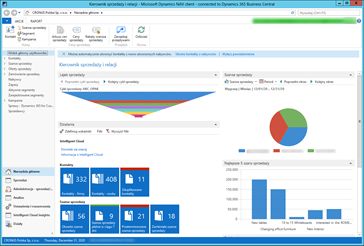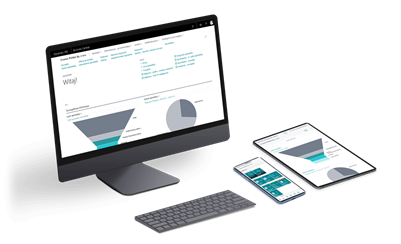Microsoft Dynamics 365 Business Central
Dynamics 365 Business Central
Microsoft Dynamics 365 Business Central (formerly known as Microsoft Dynamics NAV) is a comprehensive ERP system and its key aim is to boost the management efficiency of your business by supporting the following areas: finance, sales, customer service, and service. Due to its intuitive operation and seamless implementation, it can be an ideal solution for a small, medium-sized, or large company.
This modern platform has been enhanced by scaling and extension of functionalities within new modules that fulfil the expectations and needs of various areas of your enterprise. Thanks to it you will adjust the system to your market and business requirements without any changes in the source code.
Dynamics Business Central offers an extensive range of add-ons that will help you build a competitive advantage. You will gain:
-
- a modern and easy-to-use interface;
- rapid integration capabilities;
- flexible modules which can be customised to the needs of your enterprise;
- access to a database containing standardized data.
Dynamics 365 Business Central – Business Process Automation
Business process automation allows you to define sales and purchase documents, which in turn, will make your work with orders easier (as well as with related processes). Issuing invoices without time-consuming order registration and defining prices and discounts which are applied according to filters (e.g. an order quantity) are the key conveniences. Prices and discounts can be set in a sales document as well as in full automation which will free resources for your staff.


A Dynamics 365 Business Central (BC)helps you to fill orders in the replenishment area based on notifications concerning stocks and their forecast. However, prices are the result of previous arrangements with suppliers (during which the delivery times are calculated). All those functions make it simpler to monitor and control and analyse your expenses.
The system thanks to its capabilities influences:
- Warehouse operations. The system facilitates receiving and shipping goods from a warehouse but also enables to creation stocks and inter-warehouse transfers. Additional functions allow to collect stocks for orders and orders created in this particular area.
- Stock creation.. Mainly defined buffer stock thanks to which specific products can be offered to buyers.
- Forecasting. Both sales and stock use new technologies including machine learning. Dzięki niemu wprowadzono funkcję sprawdzania i zapowiadania sprzedaży i stanu magazynowego (wykorzyThanks to forecasting, a function dedicated to checking and forecasting sales and stock has been introduced (using historical data).stując przy tym dane historyczne).
- Creation of production orders. They are used to record and convert purchased raw materials into finished products. Those orders contain, for instance, pieces of information on the number of products.
- Forecasting. Especially, in the area of demand which can facilitate a process of planning and sales execution.
- Production planning. Sales order planning and order planning allow demand to be satisfied by various sources and to draw up a worksheet to facilitate the generation of production plans by calculating the overall stock and demand plan.
- Introduction of advanced capabilities. Mainly in the production area which is organized by determining a workplace and supervising downtime.
Dynamics 365 Business Central – Financial and Customer Service Management
Dynamics 365 Business Central (formerly known as Microsoft Navision or NAV system)is a modern system that enables you to manage sales processes, finance, and data including accounting processes (e.g. financial transactions). Thanks to them, you will draw up financial statements and stock cost analysis but also you will manage so-called fixed assets.
- Planning. It includes planning the list of accounts which is commonly used to proceed with transactions in the ledger. The plan will consist of balance sheet accounts providing among others, tax services (including VAT). The application also enables to create ledger accounts.
- Payment processing. Easier payment processing enhances internal processes within an enterprise. Advanced functions such as setting priorities at suppliers enable to process and unify the bank account statement transactions quicker.
- Forecast creation. Due to cash flow forecasting, it is possible to analyse receivables, future payments, sales orders, etc. This is all based on the latest technologies, for instance, machine learning which takes advantage of history and previously collected data.
- Creation of inter-period settlements. Thanks to billing templates it is possible to fully automate cyclical billing which includes, among others, revenues and expenses in the company.
- Budget management. Including ledger accounts, spending, sales, and made purchases.
- Management of bank accounts.. Including the needs of the company and legal and required currencies.
- Drawing up timesheets. that can be integrated with service and order functionalities. Thanks to them, it is possible to register working time spent on a particular project which is helpful while implementing improvements and noticing so-called bottlenecks.
- Contact management. Relations and contacts with customers are nearly basic data that can provide information on needs and essential future marketing activities. The function allows to register offers, and synchronize contacts with, for example, suppliers.
- Contact groups. The segments you create can be organised according to your specific criteria. It is possible to plan better, for instance, dedicated marketing campaigns, based on your data.
- Sales management. Including management of offers that can be made. This solution helps you to predict effective activities or the ones that still need to be changed. The function allows you, for instance, to assign offers directly to some potential clients and at the same time foresee the paths to purchase and create a sales funnel system.
- Customer interaction management. This functionality makes tracking interactions with contractors, customers, and suppliers possible. That is why it is possible to track interactions such as phone calls, e-correspondence, and created invitations.


Microsoft Dynamics NAV – change
Microsoft Dynamics NAV (System Navision) is a predecessor to Dynamics 365 Business Central (D365).). Among the most significant new functionalities is Role Centre which helps users to organise their work better. What about other functions of Microsoft Business Central?
- Sales forecasting. Use obtained information to sell and anticipate further steps. Create production plans and orders automatically.
- Warehouse management. Do it effectively by gaining insight into, for instance, a stock level. Fulfil orders, track transactions, plan further activities, analyse a warehouse layout and predict mistakes and bottlenecks.
- Production capacity optimization.. Calculate, deduce and optimise production capacities. Create schedules in order to meet your customers’ requirements quicker and better.
- Make better decisions Te oparte są na rzetelnie zebranych danych, które dotyczą księgowości, sprzedaży, zapasów, relacji, obsługi i procesów wewnętrznych. Improve your organisation, generate charts, draw conclusions and make plans for the future.
- Report. Prepare comprehensive reports and processes which allow you to close the financial year effectively.
- Create financial forecasts. Enhance their reliability, model, analyse, collect data in worksheets. . Draw up dedicated reports based on forecasts which later on can be integrated with, for example, Microsoft Excel.
- Stock management. Optimise them by applying built-in functionality thanks to which you will anticipate necessary activities and minimise the risk of mistakes.
- Loss avoidance. Avoid losses mainly in the sales area by maintaining the amount of stock and arranging a schedule for carrying out orders and suggesting replacement products.
- Maximise profitability. Apply suggested changes and deadlines so as to avoid penalties. Avoid controversial and unfair activities.
- Analyse and stick to a budget. Draw up and manage the budget while running projects and taking advantage of advanced reports. Calculate labour costs, develop, modify and control your finance.
- Plan. Manage and plan your activities including sales and stock. Track the level of sales, draw up offers, and plan your costs.
- Analyse performance. Make the best and wisest decisions that will have a positive impact on your business. Have an insight into the status of projects as well as their profitability and already used-up resources.
- Enhance the quality of your services. Expand your business and seek for solutions to bottlenecks, correct mistakes, and monitor and speed up the execution of orders.
- Increase sales effectiveness. Improve your activities in the scope of drawing up quotations as well as completing transactions.

